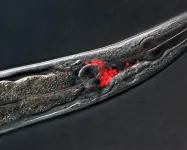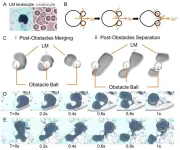(Press-News.org) A UCLA Health research team has identified changes in brain rhythms that indicate seizure activity in Alzheimer’s patients.
The findings, published in Brain Communications, build on UCLA neurologist and senior author Dr. Keith Vossel’s pioneering work that first linked silent epileptic activity to cognitive decline in Alzheimer’s disease.
Vossel’s previous studies showed that silent seizures, detected through overnight electroencephalography (EEG) and one-hour magnetoencephalography (MEG), occur in more than 40% of Alzheimer’s patients—beyond the 20% who experience overt seizures. His research has demonstrated that both silent and overt seizures accelerate cognitive decline.
In this latest study, the team including UCLA postdoctoral fellow Dr. M.C. Vishnu Shandilya, Dr. Richard Staba from the UCLA Epilepsy Center and colleagues at UCSF, analyzed MEG and EEG recordings for high-frequency oscillations (HFOs) — fast bursts of rhythmic activity first discovered by Dr. Anatol Bragin at UCLA as markers of epilepsy.
While HFOs are widely studied in epilepsy, this study is the first time they have been examined in neurodegenerative diseases. The researchers found that HFOs occur at rates two to three times higher in Alzheimer’s patients than in cognitively normal individuals. MEG proved more effective than EEG at detecting these signals due to its superior signal-to-noise properties.
The study also found that HFOs were more asymmetric (appearing more on the right side) in Alzheimer’s patients with epileptic activity. Notably, HFOs that coincided with epileptic spikes were suppressed by the antiseizure medication levetiracetam, based on data from Vossel’s Phase 2a clinical trial. These findings suggest that HFOs could serve as a critical biomarker for identifying Alzheimer’s patients at the highest risk for seizures.
“Encouragingly, MEG screening for HFOs takes just 10 minutes, offering a practical and efficient way to identify Alzheimer’s patients at higher risk of epileptic activity,” Vossel said.
Vossel’s prior research has shown that low doses of levetiracetam can improve spatial memory and problem-solving abilities in Alzheimer’s patients with epileptic activity. A quick MEG exam could therefore provide a valuable tool for early intervention—enhancing patient care while reducing healthcare costs.
END
Brain rhythms can predict seizure risk of Alzheimer’s disease patients, study finds
UCLA Health researchers say these signals can serve as critical biomarker to detect patients with high seizure risk
2025-02-13
ELSE PRESS RELEASES FROM THIS DATE:
Scientists develop innovative DNA hydrogels for sustained drug release
2025-02-13
Hydrogels are polymeric materials with three-dimensional network structures containing large amounts of water. They serve as sustained-release drug delivery systems as they can encapsulate various bioactive substances, including drugs, antigens, and even cells. Hydrogels are better drug delivery alternatives than conventional systems, as they are more biocompatible, biodegradable, and easily administered as an injectable scaffold.
DNA has gained significant attention as a promising hydrogel material thanks to its customizable physicochemical properties, leading to the development of various DNA ...
Paramedics facing challenging end-of-life care demands
2025-02-13
Paramedics in England are experiencing wide-ranging challenges in responding to the increasing number of end-of-life care patients they are being called out to, according to a study from the University of Southampton.
The study published in BMC Palliative Care highlights the issues paramedics face when responding to patients at end-of-life, including a lack of patient information, barriers to administering medication, and insufficient training.
It was funded by Marie Curie and supported by National Institute for Health and Care Research (NIHR) Applied ...
Worm study shows hyperactivated neurons cause aging-related behavioral decline
2025-02-13
A study of nematodes by researchers at Nagoya University in Japan has found that aging-related decline in brain function is caused by the excessive activation of certain neurons over time, rather than a decline in neuronal activity. This finding, published in the journal Proceedings of the National Academy of Sciences, suggests that interventions aimed at reducing neuronal hyperactivation, such as dietary changes, could potentially mitigate age-related cognitive decline.
Proper brain function occurs when a large number of neurons are connected to each other and work ...
Combining millions of years of evolution with tech wizardry: the cyborg cockroach
2025-02-13
Osaka, Japan – From disaster zones to extreme environments, there remain areas difficult for even humans to reliably access. This poses a problem for search-and-rescue operations, research, surveillance, and more. Now, however, a research team from Osaka University and Diponegoro University, Indonesia is hard at work on one potential solution: the cyborg insect.
Cyborg insects have a lot of advantages over traditional robots. Power consumption is less of an issue, so it’s easier to miniaturize them, and they are even ‘pre-built’ in a sense. However, research on cyborg insects has been limited to simple environments, like flat surfaces supplemented ...
Discrimination can arise from individual, random difference, study finds
2025-02-13
New research from the University of Sydney has found people tend to discriminate in favour of individuals who show a similarity to them, even when the similarity arises from a random event like the flip of a coin.
Published in Proceedings of the National Academy of Sciences, the research runs counter to traditional theories, in particular social identity theory, that assume discrimination occurs because we divide people into groups. It finds, instead, differences between individuals are enough to trigger discrimination.
Previous research (using the seminal ‘minimal group’ experiment) showed participants tend to financially benefit members of their own group over ...
Machine learning boosts accuracy of solar power forecasts
2025-02-13
As solar energy plays an increasing role in the global power supply, ensuring accurate forecasts of photovoltaic (PV) power generation is critical for balancing energy demand and supply. A new study published in Advances in Atmospheric Sciences explores how machine learning and statistical techniques can refine these forecasts by correcting errors in weather models.
Weather forecasts are a key input for PV power prediction models, yet they often contain systematic errors that impact accuracy. Researchers from the Institute of Statistics at the Karlsruhe Institute of Technology ...
Researchers create chemotaxic biomimetic liquid metallic leukocytes with versatile behavior
2025-02-13
Scientists led by Prof. LIU Jing from the Technical Institute of Physics and Chemistry of the Chinese Academy of Sciences (CAS) have created a leukocyte-like liquid metallic entity that vividly simulates various leukocyte behaviors in nature.
Published in Matter on February 10, the researchers demonstrated how these "liquid metallic leukocytes" can autonomously perform complex actions like engulfing foreign substances, changing shape, moving in a pulsatile manner, and even climbing against gravity—showing striking similarities to the dynamic behavior of living cells.
The research ...
Beyond DNA: How environments influence biology to make things happen
2025-02-13
RICHLAND, Wash.—Curled up inside every single one of the trillions of cells in the human body is six feet of DNA, spooled tightly and carrying the genetic instructions that govern so much of who a person becomes. It’s a nicely wrapped package of instructions for a lifetime.
But having the package in hand is a far cry from understanding how it’s executed.
It’s been 20 years since scientists completed the Human Genome Project, sequencing the entire length of DNA found in a person. Scientists have now done the same with an amazing array of organisms, including some types of worms, mice, mosquitoes, fruit flies, trees, rice and pufferfish.
Science ...
Alarming gap on girls’ sport contributes to low participation rates
2025-02-13
Researchers at Flinders University say there is an urgent need to encourage more girls to participate in sports, following a new study that reveals a striking lack of research on girls' sport engagement.
A new study in Sport in Society journal set out to review existing data on interventions to engage female adolescents in organised sport, and to explore the different factors that influence their experience and decision making in sport.
“Despite a rigorous systematic search of more than 3,000 articles, only five (globally) were found to ...
New study adds to evidence of stroke and heart attack risk with some hormonal contraceptives
2025-02-13
Certain hormonal contraceptives are associated with a higher stroke and heart attack risk, finds a large study from Denmark in The BMJ today that draws on prescription records to give more precise estimates for different products than previous studies.
The highest risk estimates were for oestrogen containing products, in particular the vaginal ring and skin patch.
The researchers stress that the absolute risk remains low, but given the widespread use of these products and the seriousness of these conditions, they say clinicians should consider these potential risks when prescribing them.
Almost 250 million women worldwide are estimated to use hormonal contraception. Previous ...
LAST 30 PRESS RELEASES:
Norbert Holtkamp appointed director of Fermi National Accelerator Laboratory
New agentic AI platform accelerates advanced optics design
Biologists discover neurons use physical signals — not electricity — to stabilize communication
Researchers discover that a hormone can access the brain by hitchhiking
University of Oklahoma researcher awarded funding to pursue AI-powered material design
Exploring how the visual system recovers following injury
Support for parents with infants at pediatric check-ups leads to better reading and math skills in elementary school
Kids’ behavioral health is a growing share of family health costs
Day & night: Cancer disrupts the brain’s natural rhythm
COVID-19 vaccination significantly reduces risk to pregnant women and baby
The role of vaccination in maternal and perinatal outcomes associated with COVID-19 in pregnancy
Mayo Clinic smartwatch system helps parents shorten and defuse children's severe tantrums early
Behavioral health spending spikes to 40% of all children’s health expenditures, nearly doubling in a decade
Digital cognitive behavioral treatment for generalized anxiety disorder
Expenditures for pediatric behavioral health care over time and estimated family financial burden
Air conditioning in nursing homes and mortality during extreme heat
The Alps to lose a record number of glaciers in the next decade
What makes a good proton conductor?
New science reporting guide published for journalists in Bulgaria
New international study reveals major survival gaps among children with cancer
New science reporting guide published for journalists in Turkey
Scientists develop a smarter mRNA therapy that knows which cells to target
Neuroanatomy-informed brain–machine hybrid intelligence for robust acoustic target detection
Eight SwRI hydrogen projects funded by ENERGYWERX
The Lundquist Institute and its start-up company Vitalex Biosciences Announces Strategic Advancement of Second-Generation fungal Vaccine VXV-01 through Phase 1 Trials under $40 Million Competitive Con
Fine particles in pollution are associated with early signs of autoimmune disease
Review article | Towards a Global Ground-Based Earth Observatory (GGBEO): Leveraging existing systems and networks
Penn and UMich create world’s smallest programmable, autonomous robots
Cleveland researchers launch first major study to address ‘hidden performance killer’ in athletes
To connect across politics, try saying what you oppose
[Press-News.org] Brain rhythms can predict seizure risk of Alzheimer’s disease patients, study findsUCLA Health researchers say these signals can serve as critical biomarker to detect patients with high seizure risk






